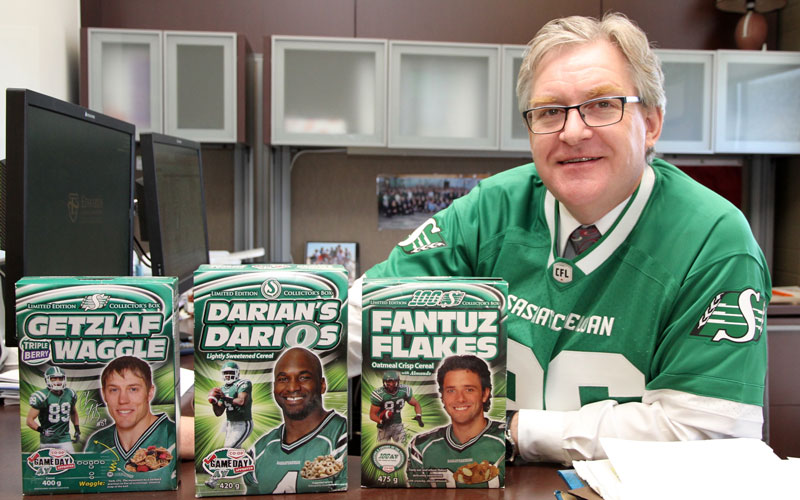
Willoughby works wonders with CFL picks
Keith Willoughby has never been more disappointed to have been right, than he was last year.
The dean of the Edwards School of Business at the University of Saskatchewan caught the ire of football fans—not to mention members of the Saskatchewan Roughriders—when his Canadian Football League (CFL) analytics model correctly predicted that the Toronto Argonauts would not only beat the Roughriders in the playoffs, but also go on to upset the Calgary Stampeders in the 2017 Grey Cup game.
Willoughby’s CFL computer simulator successfully crunched the numbers to silence the naysayers—not to mention Las Vegas oddsmakers who had picked the Stampeders as a seven-point favourite—and proved prophetic in predicting the Grey Cup champion for the third time in the last four years. But for a lifelong Roughriders fan, it was heartbreaking to have to announce that his system had picked Toronto over Saskatchewan.
“There were Roughrider players who were basically calling out the model and here I am, a Roughriders season ticket holder who bleeds green and white,” said Willoughby, whose predictions have been posted on the CFL website for each of the past four years. “But as disappointing as it was, I sort of check one off for the professor here, since the model successfully predicted the Argos would be the Grey Cup champions, when no one else was picking them.
“And once the Roughriders weren’t going to be in the Grey Cup, and Toronto went on to win it, it was satisfying because it proved the model to be right. And even looking back to the Eastern Final with Toronto and Saskatchewan, I take some comfort in the fact that the model was right.”
Willoughby’s fascination with football predates his appetite for analytics and his passion for post-secondary education.
“My real goal in life as a young boy growing up in Melfort was to play professional football,” Willoughby said, with a grin. “I wanted to play for the Saskatchewan Roughriders, but genetics was not kind to me. I was not very strong, but I made up for that by being incredibly slow!
“But mom and dad took us to all the Rider games, so we always made the pilgrimage to Regina and I continue to do that now as a season ticket holder.”
Willoughby first tackled his pet project back in 2013, inspired by a colleague’s presentation on pinpointing the playoff probability of the NHL's Edmonton Oilers.
“I thought it would be nice to do something like that for the CFL, to apply a model that looked at the chances that a team makes the playoffs, finishes first, and wins the Grey Cup,” said Willoughby. “I have some contacts in the CFL and the league was really interested in demonstrating analytics, so in 2014 they agreed to put it on the website.”
Willoughby’s spreadsheet system requires roughly half of the season to have been played to have enough data to accurately predict future results. It takes a team’s win-loss record and factors in margin of victory and wins on the road, with more emphasis on beating stronger teams and heavily weighting more recent results. The model then simulates 10,000 replications of the remaining games to project first-place finishers in each division, pick playoff winners and the Grey Cup champion.
“It’s not quantum physics,” said Willoughby. “In essence, it’s a spreadsheet model, but I think what really captures the attention of my colleagues in academia is when they see the public takes interest, whether it is media interviews or the CFL website. The model sort of bridges that connection to real-world understanding.”
Willoughby has used the model in the classroom in business courses as an example of the successful application of analytics, and has also presented it at a number of conferences. Now entering his fifth season, Willoughby continues to fine-tune his system and would like to also incorporate in-game analytics.
“That’s the next step: in-game analytics to determine the probability of your team winning, while you are watching the game,” he said. “So, there’s three minutes left in the game and the Riders are down by 10, can I turn off the TV?”
This summer, Willoughby is also kicking off his next project, analyzing the importance of Canadian talent in building championship teams, since CFL teams must have 21 nationals (largely Canadian-born players from teams like the U of S Huskies) on their 44-player rosters.
“Canadians are basically half of your team and such a key component, so how do you build through the draft? I am going to be doing some analysis this summer, working with a student to do 25 years’ worth of CFL draft results to see how you can tease out some of the analytics,” said Willoughby.
As for this CFL season, which begins June 14, it’s too early to accurately predict whether his beloved Roughriders will make the Grey Cup. However, there’s no question where his heart lies.
“I don’t want to give the Riders the kiss of death, but as a fan, I am very confident in the Roughriders this year,” said Willoughby. “I haven’t done any modelling yet, but I think we’re looking at a Saskatchewan-Toronto Grey Cup.”
